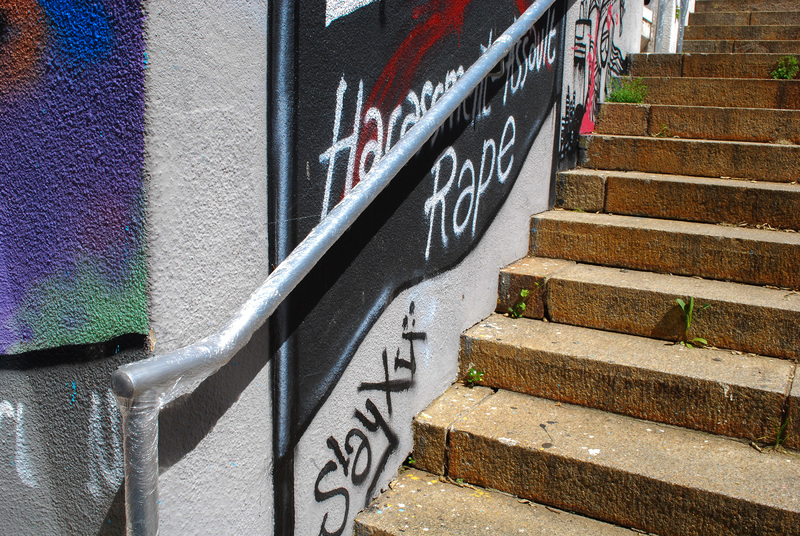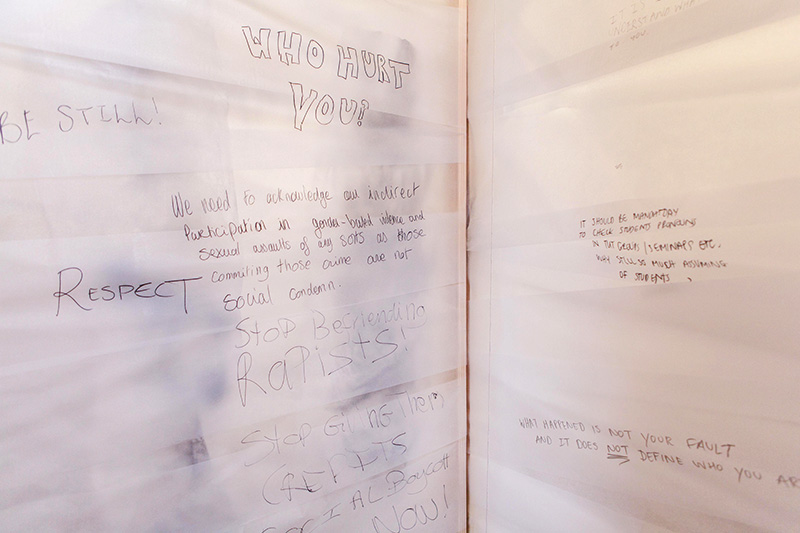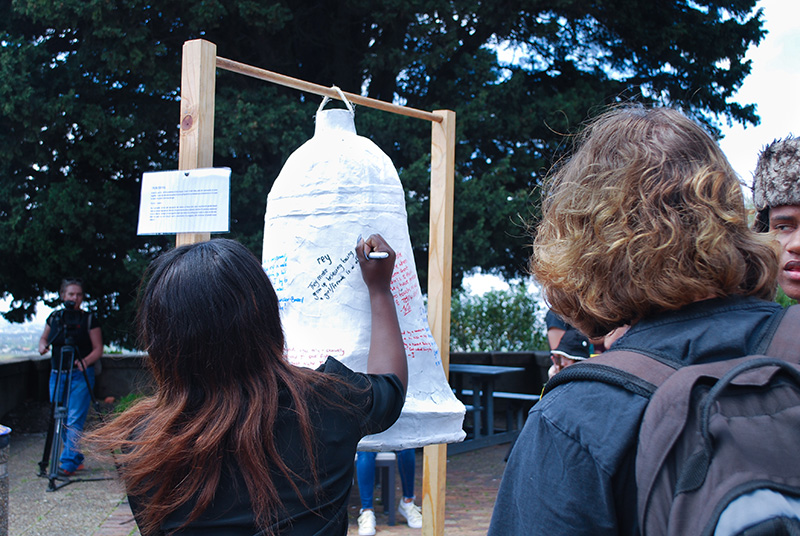Spotlight on gender-based violence
22 October 2018 | Story Supplied. Read time >10 min.
The University of Cape Town’s (UCT) Michaelis School of Fine Art was the venue for this year’s annual collaborative public art project, which aimed to lay bare the invisibility of gender-based violence in our daily routines.
The first indication was on the front door of the Bertram building on the Hiddingh campus – a sticky note bearing the word “Ssssh!”. It was just one of the myriad sticky notes that first-year Fine Arts students had attached to cars, doorways, fire extinguishers, chairs, under desks, on stop signs and on the stairs.
Along with placing coloured tape lines on the tarmac, some students also knotted skewers with twine, while another group made a video of polystyrene being submerged in a container of liquid.
The message? Raising awareness of the invisibility of gender-based violence as we go about our daily lives.
The public art project is an annual collaboration between the art school and UCT’s Office for Inclusivity and Change (OIC), giving students a platform to experiment with the intersection of art, public space and social justice issues, according to lecturer Fabian Saptouw.
“When students are alerted to the frequency of sexual assault the first response is always shock and slight disbelief. This year the students sought to create moments of reflection in which we re-evaluate how we position ourselves in relation to gender-based violence,” he said, adding that the focus dovetailed with the intention of The Daily Abuse, published earlier this year by People Opposing Women’s Abuse (POWA).
The publication was focused on providing a human contact point to allow people to relate to incidents of gender-based violence and its impact on the lived experience, rather than dealing with the issue only in terms of abstract statistics.
“When students are alerted to the frequency of sexual assault the first response is always shock and slight disbelief.”
This year’s event encouraged audience interaction via an unexpected aesthetic encounter, engaging the viewer by disrupting their daily routine.
Saptouw said the current group of students was very interested in moving away from the confrontational and didactic dialogues prevalent in the media, attempting to focus instead on the everyday moments and materials surrounding us as a way to bear witness to the magnitude of the crisis.

Unexpected aesthetic encounter
“The group tackled the challenge of exploring the imaginative possibilities of ubiquitous material with enthusiasm, and developed a range of proposals. They worked with toothpicks, paper plates, wax wrap, cling film, sticky notes, A4 paper and Sellotape, using the materials as the starting point.
“Various other items were added during the creative process, including wood, glue, ink, pencils, markers, wire, paint, gut, thread, plastic, craft knives, and even a collection of tiny bells.”
Other than creating an intervention in a public place, this year’s students were also challenged to curate the experience for visitors to the ZK Matthews Gallery in the Hoerikwaggo building, which is home to the Centre for Higher Education Development (CHED).
One of the projects that included a participatory element was the distribution of a series of paper keys to the student body.
“The notion of ‘safety’ and ‘access’ are quite difficult to discuss in the South African context without being drawn into contentious territory. In this instance, the duplication of each student’s keys functioned as an act of vulnerability,” Saptouw explained.
“The interaction with a stranger opened up a space of conversation about a complex issue with direct links to the perceptions of the performance of knowledge, power and gender.”
While the group intended that the keys remain on display in a public space, the participants elected to keep them as a personal reminder of their interaction.
Another project, linked to the idea of bearing silent witness to a single transitionary moment, was the chemical interaction between large sheets of foam in a bath of solvent. Highly noxious gases were released as the foam sheets melted into the corrosive substance.
“While quite evocative on a visual level, the work also spoke to the environmental implications of our use of various resources in a self-destructive manner,” he said, adding that weather and safety-related issues had prevented multiple repeats of the performance, which meant it unfortunately wasn’t widely viewed.
In contrast to this subtle intervention was the large white papier-mâché bell on the Plaza, visible from many vantage points and which drew a crowd of students who wrote on it with markers about their experiences and opinions on gender-based violence. They were interested in the metaphor of sounding the bell as a call to action.
Saptouw said another work that utilised the concept of sound to attract the audience was a curtain of toothpicks, skewers and thread suspended between the pillars of the ZK Matthews Gallery.
“I watched many viewers gently trace their hands along the surface of the installation to illicit a soft tapping sound as the tiny pieces of wood connected with each other. To hear the sound the viewer had to hold their breath, lean in close and listen very carefully,” he said.
“Experiencing the auditory component was quite challenging given the number of students [who] were typing, talking and walking through the venue. The intimacy of the action seemed so foreign in that context and made you very aware of the fragility of the artwork.”

Deeply personal truths
A similar level of intimacy was elicited by the wax paper booth that was placed in the corner of Molly Blackburn Hall. Participants capitalised on the privacy of the interior space and used the walls to express deeply personal truths about their experiences of sexual assault.
“It was extremely poignant to see statements reflecting such trauma, vulnerability and bravery on campus,” he said.
“Having these intensely personal statements separated from the hustle and bustle of the venue by nothing more than a translucent sheet of wax paper was a very powerful metaphor for the way trauma survivors feel on a daily basis.”
The group of students working with sticky notes wanted to find a way to incorporate the project into their daily routine, marking the frequency of sexual assault by placing a sticky note on a surface in their immediate proximity every four minutes.
“That tiny action shifted the way the students participating in this project experienced the spaces on campus, along with [their] understanding of the magnitude of the challenge that faces South Africa. The awareness of statistics and taking the time to acknowledge its impact on the lived experience are two very different things,” Saptouw explained.
“Having these intensely personal statements separated from the hustle and bustle of the venue by nothing more than a translucent sheet of wax paper was a very powerful metaphor for the way trauma survivors feel on a daily basis.”
“This shifted the disassociation that often takes place in the minds of the public, and made it a personal experience for the group members.”
Groups working with cling film and tape connected with viewers by “leaving a trace in the environment”. They wrapped more than 100 metres of cling film over the railings running the full length of the passage under Rhodes Drive, the disappearance of the work into the landscape echoing the invisibility of the issue of gender-based violence in South Africa.
Similarly, the thin strips of tape placed on the floor were also rendered nearly invisible by the darkness of the passage.
“This play on the visibility and invisibility of the intervention was quite effective on a conceptual level. Multiple rolls of tape were utilised to mark the terrain from lower to upper campus. This reclaiming of the space was a very effective strategy as the students traversed spaces in which they experienced incidents of gender-based violence,” he said.
Ultimately, Saptouw explained, the artistic interventions in the UCT environment were intended to “create a brief moment of reflection”.
 This work is licensed under a Creative Commons Attribution-NoDerivatives 4.0 International License.
This work is licensed under a Creative Commons Attribution-NoDerivatives 4.0 International License.
Please view the republishing articles page for more information.










